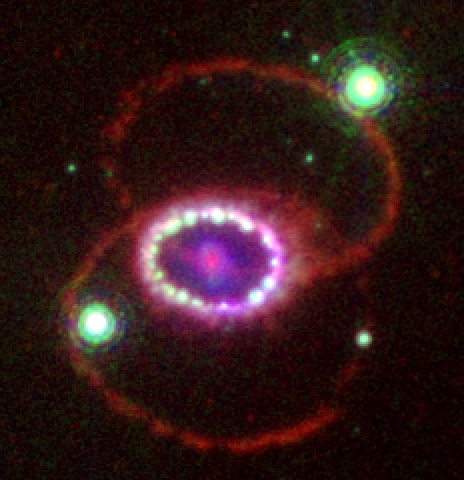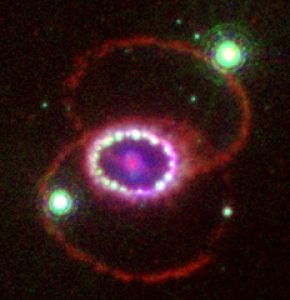News observations with the refurbished Hubble Space Telescope
An international team of astronomers/astrophysicists that includes a member of the Service d’Astrophysique (CEA-Irfu, Saclay) has obtained new data of the spectacular surroundings of the famous supernova SN 1987A using the recently refurbished Hubble Space Telescope. New spectroscopic data, long awaited since the failure of the STIS instrument in 2004, allow pursuing the study of the inner equatorial ring, of its hot spots, and of the shocks induced by the explosion. The scientists observe, as predicted, a significant brightening of the emissions from the supernova, and report that radiation from the hot spots towards the center of the supernova interacts with neutral hydrogen and gets reflected back out. They also discovered possible ultraviolet emissions from quadrupled-ionized nitrogen ions, very sensitive to the still very poorly known surrounding magnetic fields. These new results, which appear in the September 2 issue of Science Magazine, illustrate the success of the last servicing mission of the Hubble Space Telescope.

SN1987A images obtained with the Hubble Space Telescope between 1994 and 2006. The gas ring likely was shed some 20,000 years before the supernova exploded, and the intense flash of light emitted by the explosion makes it glow. Hot spots appear and grow with time inside the ring as the result of shock waves rushing out from the remnant hitting denser concentrations of matter. More than 30 hot spots are observed today (2010) and will likely merge together in the coming years to form a continuous glowing circle. Credit : Peter Challis, Zolt Levay, for STScI and SAINTS team.
An orphan program born again
A large observing program in the UV and visible light, is carried out since the beginning of the 90’s by the SAINTS team (Supernova SN 1987A Intensive Study) [2], in particular with the Hubble Space Telescope, to study the surrounding of supernova SN1987A [1]. A progressive formation of hot spots is being observed in the inner equatorial ring, located closest to the supernova (at 0.7 lyr). They are believed to be due to long fingers of dense gas pointing towards the center of the supernova. As the explosion hits the fingers, it heats them up; they subsequently cool down, emit radiation and are observed as hot spots. This observing program had to stop in August 2004 due to a faulty circuit board on the Space Telescope Imaging Spectrograph (STIS). The final repair mission in May 2009 by NASA astronauts (Servicing Mission 4) allowed the program to be resumed.
Ping-pong playing photons
The analysis of the new data, collected in January 2010, allows the SAINTS team to report that radiation travelling from the hot spots towards the center of the supernova interacts with neutral hydrogen atoms and gets reflected back out, and that this process may be a dominant source of the ultraviolet radiation from supernova 1987A. This “ping-pong” playing is due to the various shocks (the forward shock of the explosion gives rise to a reverse one going inward when it hits a denser medium, as the hot spots are) that show up in the observations at various positions and velocities.

Moreover UV observations in another hydrogen transition (Lyman alpha at 1216 Angström) which can be achieved from space only, allow characterizing the structure and the geometry of the shocks. The SAINTS team also found tentative evidence for ultraviolet emission from quadrupled-ionized nitrogen ions, which may provide an excellent (and unique!) way of probing the magnetic fields surrounding the supernova, which is still a major unknown. Forthcoming observations with the Cosmic Origins Spectrograph (COS), installed also onboard the Hubble telescope during the same servicing mission 4, and which is more sensitive than STIS, should check if the ultraviolet emission observed by STIS is indeed due to the nitrogen ions.
The study of the shocks, of the rings, and of its components (in particular the hot spots) is still on-going not only with the Hubble Space Telescope, but also with the ESO VLT, in the visible and in the infrared light. The timescale of the variations in the SN 1987A surroundings (a couple of months only) gives scientist an unique opportunity for following “live” the formation of a SuperNova Remnant (SNR), one of the most spectacular celestial objects.
Contact : Patrice Bouchet
« Observing Supernova 1987A with the Refurbished Hubble Space Telescope »
Kevin France, Richard McCray, Kevin Heng, Robert P. Kirshner, Peter Challis, Patrice Bouchet, Arlin Crotts Eli Dwek, Claes Fransson, Peter M. Garnavich, Josefin Larsson, Peter Lundqvist, Nino Panagia, Chun S. J. Pun, Nathan Smith, Jesper Sollerman, George Sonneborn, John T. Stocke, J. Craig Wheeler
Published in the review Science Express, 2010, Septembre 2, pdf file (2 Mb)
See also : The NASA/STScI press release
Notes :
[1] SN1987A : Located 170 000 light year away in the Large Magellanic Cloud, the explosion of star Sanduleak -69°202 on February 23, 1987, was a truly exceptional event for being the first star explosion that was visible with the naked eye since Kepler’s supernova in 1604, that is more that 400 years ago.. After more than 30 years observing, various characteristics of this supernova, so-called SN 1987A, are still unknown. This is the case for instance for the origin of the 3 rings of matter that surrounded the star before it exploded. These rings could have been formed through the mass loss events that affect highly rotating supergiant stars. Alternatively, they could result from the merging of a binary system enshrouded in a common envelope.
[2] SAINTS : The SAINTS team (Supernova 1987A Intensive Study) includes twenty astronomers/astrophysicists from 10 institutes and universities in the US [California (Berkeley), Colombia, Colorado (Boulder), Harvard, Notre Dame, Princeton, Texas (A&M and Austin), NASA Goddard Space Flight Center, and the Space Telescope Science Institute (STScI)], 4 institutes in Europe [Astronomy Zurich, Stockholm University, Astrophysical Observatory of Catania (INAF), and IRFU Service d’Astrophysique at CEA], as well as Hong Kong University in China. The team is lead by Prof. Robert Kirshner from Harvard University, and Prof. Richard McCray from Colorado University at Boulder.
Written by : P. Bouchet et C. Gouiffès


